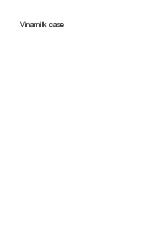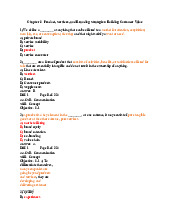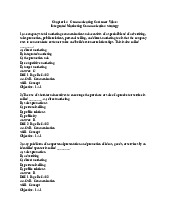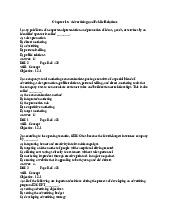



















Preview text:
lOMoAR cPSD| 58097008
Chapter 10 Pricing Products: Understanding and Capturing Customer Value
1) ________ is the amount of money charged for a product or service. A) Experience curve B) Demand curve C) Price D) Wage E) Salary Answer: C Diff: 1 Page Ref: 290 Skill: Concept Objective: 10-1
2) Price is the only element in the marketing mix that produces ________. A) revenue B) variable costs C) expenses D) outfixed costs E) stability Answer: A Diff: 1 Page Ref: 290 Skill: Concept Objective: 10-1
3) ________ is an important element in the marketing mix. It is the only element that does not represent costs.
A) Current profit maximization B) Market share leadership C) Price D) Product quality leadership E) The target market Answer: C Diff: 1 Page Ref: 290 Skill: Concept Objective: 10-1
4) Consumer perceptions of the product's value set the ________ for prices. A) demand curve B) floor C) ceiling D) variable cost E) image Answer: C Diff: 2 Page Ref: 291 lOMoAR cPSD| 58097008 Skill: Concept Objective: 10-2
5) Product costs set a(n) ________ to a product's price. A) demand curve B) floor C) ceiling D) break-even cost E) experience curve Answer: B Diff: 2 Page Ref: 291 Skill: Concept Objective: 10-2
6) Which of the following is a customer-oriented approach to pricing? A) value-based pricing B) sealed-bid pricing C) break-even pricing D) target profit pricing E) C and D Answer: A Diff: 2 Page Ref: 291 Skill: Concept Objective: 10-2
7) ________ uses buyers' perceptions( nhận thức) of what a product is worth, not the seller's
cost, as the key to pricing. A) Value-based pricing B) Value-added pricing C) Variable cost D) Price elasticity E) Product image Answer: A Diff: 2 Page Ref: 291 Skill: Concept Objective: 10-2
8) In ________, price is considered along with the other marketing mix variables before the
marketing program is set. A) value-based pricing B) cost-based pricing C) variable costs D) price elasticity E) building the marketing mix Answer: A Diff: 2 Page Ref: 291 lOMoAR cPSD| 58097008 Skill: Concept Objective: 10-2
9) Value-based pricing is the reverse process of ________. A) variable cost pricing B) cost-plus pricing C) cost-based pricing D) good-value pricing E) value-added pricing Answer: C Diff: 2 Page Ref: 291 Skill: Concept Objective: 10-2
10) With ________, price is set to match consumers' perceptions of product value. A) variable cost pricing B) cost-plus pricing C) cost-based pricing D) value-based pricing E) every day low pricing Answer: D Diff: 2 Page Ref: 291 Skill: Concept Objective: 10-2
11) Measuring ________ can be difficult. A company might conduct surveys or experiments to
test this in the different products they offer. A) price elasticity B) the demand curve C) perceived value D) break-even pricing E) quantity supplied Answer: C Diff: 3 Page Ref: 292 AACSB: Communication Skill: Concept Objective: 10-2
12) Underpriced products sell very well, but they produce less revenue than they would have if
price were raised to the ________ level. A) perceived B) value-based C) variable D) demand curve lOMoAR cPSD| 58097008 E) price-floor Answer: A Diff: 2 Page Ref: 292 Skill: Concept Objective: 10-2
13) If a seller charges ________ than the buyer's perceived value, the company's sales will ________. A) more; benefit B) more; suffer C) less; increase D) less; suffer E) none of the above Answer: B Diff: 2 Page Ref: 292 Skill: Concept Objective: 10-2
14) Some companies have adopted a ________ strategy, offering just the right combination of
quality and good service at a fair price. A) value-based pricing B) good-value pricing C) cost-plus pricing D) low-price image E) none of the above Answer: B Diff: 1 Page Ref: 293 Skill: Concept Objective: 10-2
15) Wal-Mart is famous for using what important type of value pricing? A) competition-based pricing B) everyday low pricing C) cost-plus pricing D) break-even pricing E) penetration pricing Answer: B Diff: 2 Page Ref: 293 Skill: Concept Objective: 10-2
16) ________ involves charging a constant, everyday low price with few or no temporary price
discounts. A) High-low pricing B) Target pricing lOMoAR cPSD| 58097008 C) Cost-plus pricing D) EDLP E) Penetration pricing Answer: D Diff: 2 Page Ref: 293 Skill: Concept Objective: 10-2
17) ________ involves attaching features and services to differentiate a company's offers and to
support charging higher prices.. A) Break-even pricing B) Target pricing C) Value-added pricing D) Cost-plus pricing E) Pricing-down Answer: C Diff: 1 Page Ref: 293 Skill: Concept Objective: 10-2
18) ________ is a company's power to escape price competition and to justify higher prices and margins. A) Variable cost B) Pricing power C) Target cost D) Fixed cost E) Unit cost Answer: B Diff: 2 Page Ref: 293 Skill: Concept Objective: 10-2
19) To maintain and increase a company's ________, a firm must retain or build the value of its
marketing offer. A) variable cost B) pricing power C) target cost D) fixed cost E) image Answer: B Diff: 3 Page Ref: 293 Skill: Concept Objective: 10-2
20) When there is price competition, many companies adopt ________ rather than cutting prices
to match competitors. A) pricing power lOMoAR cPSD| 58097008 B) value-added strategies C) fixed costs D) price elasticity E) image pricing Answer: B Diff: 2 Page Ref: 293 Skill: Concept Objective: 10-2
21) Ryanair offers free flights to a quarter of its customers and rock-bottom prices to many of its
other customers. Ryanair then charges for all extra services, such as baggage handling and
inflight refreshments. Which of the following best describes Ryanair's pricing method? A) value-added pricing B) low-cost pricing C) cost-plus pricing D) high-low pricing E) image pricing Answer: B Diff: 2 Page Ref: 295 Skill: Concept Objective: 10-2
22) ________ pricing involves setting prices based on the costs for producing, distributing, and
selling the product plus a fair rate of return for the company's efforts and risks. A) Value-based B) Fixed cost C) Cost-based D) Variable E) Skimming Answer: C Diff: 1 Page Ref: 295 Skill: Concept Objective: 10-3
23) Fixed costs ________ as the number of units produced increases. A) decrease B) increase C) divide in half D) remain the same
E) increase at a diminishing rate Answer: D Diff: 2 Page Ref: 295 Skill: Concept lOMoAR cPSD| 58097008 Objective: 10-3
24) Costs that do not vary with production or sales level are referred to as ________. A) fixed costs B) variable costs C) target costs D) total costs E) unit costs Answer: A Diff: 1 Page Ref: 295 Skill: Concept Objective: 10-3
25) Rent, electricity and executive salaries are examples of ________. A) fixed costs B) variable costs C) accumulated costs D) total costs E) marketing costs Answer: A Diff: 2 Page Ref: 295 Skill: Concept Objective: 10-3
26) Costs that vary directly with the level of production are referred to as ________. A) fixed costs B) variable costs C) target costs D) total costs E) unit costs Answer: B Diff: 1 Page Ref: 296 Skill: Concept Objective: 10-3
27) ________ are the sum of the ________ and ________ for any given level of production.
A) Fixed costs; variable; total costs
B) Fixed costs; total; variable costs
C) Variable costs; fixed; total costs
D) Total costs; fixed; variable costs
E) Break-even costs; fixed; total costs Answer: D Diff: 2 Page Ref: 296 Skill: Concept lOMoAR cPSD| 58097008 Objective: 10-3
28) SRAC is the acronym for which concept related to costs at different levels of production?
A) strategic reasoning and costs B) short-run accounting costs C) short-run average cost
D) strategic rights and company
E) strategic revenues and costs Answer: C Diff: 2 Page Ref: 296 Skill: Concept Objective: 10-3
29) As production workers become better organized and more familiar with equipment, the
average cost per unit decreases. This is called the ________. A) demand curve B) experience curve
C) short-run average cost curve
D) long-run average cost curve E) marginal utility Answer: B Diff: 1 Page Ref: 296 Skill: Concept Objective: 10-3
30) With a higher volume of product, most companies can expect to ________. A) gain economies of scale B) become less efficient C) see average costs increase
D) have a straight, horizontal learning curve
E) find competitors using the experience curve strategically Answer: A Diff: 2 Page Ref: 296 Skill: Concept Objective: 10-3
31) The experience curve reveals that ________.
A) repetition in production lowers costs
B) repetition in production enhances efficiency
C) the average cost drops with accumulated production experience D) A, B, and C E) none of the above Answer: D Diff: 3 Page Ref: 296 lOMoAR cPSD| 58097008 Skill: Concept Objective: 10-3
32) When a downward-sloping experience curve exists, a company should usually ________ the
selling price of that product in order to bring in higher revenues. A) increase B) greatly increase C) decrease D) not alter E) none of the above Answer: C Diff: 3 Page Ref: 297 Skill: Concept Objective: 10-3
33) Which of the following is a risk a company takes when building a strategy around the experience curve?
A) Competitors will likely not be able to meet the company's price cuts.
B) Existing technologies are likely to become more expensive as the company expands.
C) The method does not take competitors' prices into account.
D) The method may cause consumers to become frustrated with changing prices.
E) Aggressive pricing may give the product a cheap image, causing customers to lose interest. Answer: E Diff: 2 Page Ref: 297 Skill: Concept Objective: 10-3
34) A company building its pricing strategy around the experience curve would be likely to ________. A) price its products low B) price its products high
C) engage in break-even pricing D) all of the above E) none of the above Answer: A Diff: 3 Page Ref: 297 Skill: Concept Objective: 10-3
35) The company designs what it considers to be a good product, totals the expenses of making
the product, and sets a price that adds a standard mark-up to the cost of the product. This
approach to pricing is called ________. A) value-based pricing B) fixed cost pricing C) cost-plus pricing lOMoAR cPSD| 58097008 D) variable pricing E) skimming pricing Answer: C Diff: 1 Page Ref: 297 Skill: Concept Objective: 10-3
36) Lawyers, accountants, and other professionals typically price by adding a standard markup
for profit. This is known as ________. A) variable costs B) cost-plus pricing C) value-based pricing D) break-even price E) penetration pricing Answer: B Diff: 2 Page Ref: 297 Skill: Concept Objective: 10-3
37) The simplest pricing method is ________. A) value-based pricing
B) going-rate and sealed-bid pricing C) cost-plus pricing D) break-even analysis E) target profit pricing Answer: C Diff: 2 Page Ref: 297 Skill: Concept Objective: 10-3
38) Which of the following is a reason why markup pricing is NOT practical?
A) Sellers earn a fair return on their investment.
B) By tying the price to cost, sellers simplify pricing.
C) When all firms in the industry use this pricing method, prices tend to be similar.
D) This method ignores demand.
E) With a standard markup, consumers know when they are being overcharged. Answer: D Diff: 3 Page Ref: 298 Skill: Concept Objective: 10-3
39) One reason ________ remains popular is that sellers are more certain about costs than about demand. A) markup pricing lOMoAR cPSD| 58097008 B) variable pricing C) inelasticity pricing D) elasticity pricing E) penetration pricing Answer: A Diff: 2 Page Ref: 298 Skill: Concept Objective: 10-3
40) Price competition is minimized when all firms in an industry use which pricing method? A) variable pricing B) markup pricing C) elasticity pricing D) value-added pricing E) value-based pricing Answer: B Diff: 3 Page Ref: 298 Skill: Concept Objective: 10-3
41) Many people feel that ________ pricing is fairer to both buyers and sellers. Sellers earn a fair
return on their investment but do not take advantage of buyers when buyers' demand becomes great. A) variable B) markup C) elasticity D) inelasticityE) penetration Answer: B Diff: 2 Page Ref: 298 AACSB: Ethical Reasoning Skill: Concept Objective: 10-3
42) Which of the following is a cost-based approach to pricing? A) value-based pricing B) going-rate pricing C) target profit pricing D) good value pricing E) A and C Answer: C Diff: 2 Page Ref: 298 Skill: Concept Objective: 10-3
43) Break-even pricing, or a variation called ________, is when the firm tries to determine the
price at which it will break even or make the profit it is seeking. lOMoAR cPSD| 58097008 A) competition-based pricing B) target profit pricing C) fixed cost pricing D) value-based pricing E) customer-based pricing Answer: B Diff: 1 Page Ref: 298 Skill: Concept Objective: 10-3
44) Target profit pricing uses the concept of a ________, which shows the total cost and total
revenue expected at different sales volume levels. A) value-based chart B) break-even chart C) competition-based chart D) demand-curve E) unit cost Answer: B Diff: 2 Page Ref: 298 Skill: Concept Objective: 10-3
45) The break-even volume is the point at which ________.
A) the total revenue and total costs lines intersect B) demand equals supply
C) the production of one more unit will not increase profit
D) the company can pay all of its long-term debt
E) a firm's profit goal is reached Answer: A Diff: 3 Page Ref: 298 Skill: Concept Objective: 10-3
46) ________ pricing works only if that price actually brings in the expected level of sales. A) Elasticity B) Markup C) Variable D) Inelasticity E) Target profit Answer: E Diff: 3 Page Ref: 298 Skill: Concept Objective: 10-3 lOMoAR cPSD| 58097008
47) Which of the following statements about break-even analysis is true?
A) It is used to determine how much production experience a company must have to achieve desired efficiencies.
B) It is a technique used to calculate fixed costs.
C) It determines the amount of retained earnings a company will have during an accounting period.
D) It is a technique marketers use to examine the relationship between supply and demand.
E) It is calculated using variable costs, the unit price, and fixed costs. Answer: E Diff: 3 Page Ref: 298 Skill: Concept Objective: 10-3
48) As a manufacturer increases price, the ________ drops. A) target B) break-even volume C) cost-plus pricing D) total cost E) sales Answer: B Diff: 3 Page Ref: 299 Skill: Concept Objective: 10-3
49) Which of the following is an external factor that affects pricing decisions?
A) the salaries of production management B) competition
C) the salaries of finance management
D) funds expensed to clean production equipment E) A, B, and C Answer: B Diff: 1 Page Ref: 299 Skill: Concept Objective: 10-4
50) ________ that influence pricing decisions include the nature of the market and demand and
competitors' prices. A) Internal factors B) Elasticity factors C) External factors D) Target factors E) Domestic factors Answer: C Diff: 2 Page Ref: 299 lOMoAR cPSD| 58097008 Skill: Concept Objective: 10-4
51) Companies may set prices low for which of the following reasons EXCEPT ________.
A) to prevent competition from entering the market B) to stabilize the market
C) to create excitement for a product
D) to prepare for an easy exit from a market E) to match a competitor Answer: D Diff: 2 Page Ref: 299 Skill: Concept Objective: 10-4
52) In order to form a consistent and effective integrated marketing program, price decisions
should be coordinated with each of the following EXCEPT ________. A) product design B) distribution C) competitors' prices D) promotion decisions E) marketing objectives Answer: C Diff: 2 Page Ref: 299 Skill: Concept Objective: 10-4
53) With target costing, marketers will first ________ and then ________.
A) build the marketing mix; identify the target market
B) identify the target market; build the marketing mix
C) design the product; determine its cost
D) use skimming pricing; penetrating pricing
E) determine a selling price; target costs to ensure that the price is met Answer: E Diff: 2 Page Ref: 300 Skill: Concept Objective: 10-4
54) Price setting is usually determined by ________ in small companies. A) top management B) marketing departments C) sales departments D) divisional managers E) cross-functional teams Answer: A lOMoAR cPSD| 58097008 Diff: 2 Page Ref: 300 Skill: Concept Objective: 10-4
55) Price setting is usually determined by ________ in large companies. A) top management B) divisional managers C) product line managers D) pricing departments E) both B and C Answer: E Diff: 2 Page Ref: 300 Skill: Concept Objective: 10-4
56) In industrial markets, ________ typically has the final say in setting the pricing objectives and policies of a company. A) the sales manager B) top management C) the production manager D) the finance manager E) the pricing department Answer: B Diff: 2 Page Ref: 300 Skill: Concept Objective: 10-4
57) In industries in which pricing is a key factor, ________ often set the best prices or help others in setting them. A) sales managers B) top managers C) production managers D) finance managers E) pricing departments Answer: E Diff: 2 Page Ref: 300 Skill: Concept Objective: 10-4
58) Under ________, the market consists of many buyers and sellers trading in a uniform
commodity such as wheat, copper, or financial securities. A) pure competition B) monopolistic competition C) oligopolistic competition lOMoAR cPSD| 58097008 D) a pure monopoly E) anti-trust agreements Answer: A Diff: 2 Page Ref: 302 Skill: Concept Objective: 10-4
59) Under ________, the market consists of many buyers and sellers who trade over a range of
prices rather than a single market price. A) pure competition B) monopolistic competition C) oligopolistic competition D) pure monopoly E) socialism Answer: B Diff: 2 Page Ref: 302 Skill: Concept Objective: 10-4
60) Under ________, the market consists of a few sellers who are highly sensitive to each other's
pricing and marketing strategies. A) pure competition B) monopolistic competition C) oligopolistic competition D) pure monopoly E) capitalism Answer: C Diff: 2 Page Ref: 302 Skill: Concept Objective: 10-4
61) Nonregulated monopolies are free to price at what the market will bear. However, they do
not always charge the full price for a number of reasons. What is NOT one of those reasons?
A) They don't want to attract competition.
B) They want to penetrate the market faster with a low price.
C) They have a fear of government regulation.
D) They want to encourage government regulations.
E) They want to please a large group of consumers. Answer: D Diff: 3 Page Ref: 303 Skill: Concept Objective: 10-4
62) The relationship between the price charged and the resulting demand level can be shown as the ________. A) demand curve lOMoAR cPSD| 58097008 B) variable cost C) target cost D) break-even pricing E) experience curve Answer: A Diff: 1 Page Ref: 303 Skill: Concept Objective: 10-4
63) Consumers usually perceive higher-priced products as ________.
A) out of reach for most people B) having high quality C) having high profit margins D) having cost-based prices
E) being in the introductory stage of the product life cycle Answer: B Diff: 3 Page Ref: 303 Skill: Concept Objective: 10-4
64) Why do marketers consider prestige goods to be an exception to the typical demand curve?
A) The demand curve for prestige goods slopes downward and to the right.
B) Increasing the price of prestige goods can make them seem more desirable.
C) Demand for prestige goods often is greater than supply.
D) Prestige products such as diamonds, sapphires, and emeralds are nonrenewable resources.
E) Customers are more aware of any price changes to prestige goods. Answer: B Diff: 3 Page Ref: 303 Skill: Concept Objective: 10-4
65) Which of the following is true about the demand curve?
A) It is used to illustrate the effect of price on the quantity supplied.
B) It is always graphically depicted by a straight line.
C) It shows the quantity of product customers will buy in a market during a period of time even if other factors change.
D) It usually slopes upward and to the right.
E) It shows the relationship between product demand and product price. Answer: E Diff: 3 Page Ref: 303 Skill: Concept Objective: 10-4 lOMoAR cPSD| 58097008
66) When Gibson Guitar Corporation, long known for its high quality instruments, lowered its
prices to compete more effectively with Japanese rivals, the company sold fewer guitars. Which
of the following best explains this?
A) The Gibson guitars were not as well made as the Japanese guitars.
B) The market was already flooded with guitars.
C) The sound of the Gibson guitar was not as good as the Japanese guitars.
D) Customers did not distinguish the superiority of the Gibson guitar when it was at a lower price.
E) Customers had come to expect a higher price for a Gibson guitar. Answer: D Diff: 3 Page Ref: 303 Skill: Concept Objective: 10-4
67) ________ describes how responsive demand will be to a change in price.
A) Price elasticity Độ co giãn của gián B) Break-even pricing C) The demand curve D) Target costing E) Supply Answer: A Diff: 1 Page Ref: 304 Skill: Concept Objective: 10-4
68) If demand hardly changes with a small change in price, we say the demand is ________. A) variable B) inelastic C) value-based D) at break-even pricing E) market penetrating Answer: B Diff: 2 Page Ref: 304 Skill: Concept Objective: 10-4
69) If demand changes greatly with a small change in price, we say the demand is ________. A) variable B) inelastic C) value-based D) elastic E) fixed Answer: D Diff: 1 Page Ref: 304 lOMoAR cPSD| 58097008 Skill: Concept Objective: 10-4
70) Price elasticity of demand is ________ divided by ________.
A) percent change in quantity demanded; percent change in price B) demand; price
C) percent change in price; percent change in quantity demanded
D) the going price; the asking price E) none of the above Answer: A Diff: 2 Page Ref: 304 Skill: Concept Objective: 10-4
71) Buyers are less price sensitive in all of the following situations EXCEPT ________.
A) when the product they are buying is unique
B) when the product they are buying is in high demand
C) when substitute products are hard to find
D) when the total expenditure for a product is high relative to their income
E) when the product is a specialty product Answer: D Diff: 2 Page Ref: 304 Skill: Concept Objective: 10-4
72) The less ________ the demand, the ________ it pays for the seller to raise the price. A) determined; less B) elastic; more C) elastic; less D) constant; more E) none of the above Answer: B Diff: 3 Page Ref: 304 Skill: Concept Objective: 10-4
73) Each of the following economic factors can have a strong impact on a firm's pricing strategy EXCEPT ________. A) an economic boom
B) the reseller's reaction to price changes C) an economic recession D) inflation E) interest rates Answer: B lOMoAR cPSD| 58097008 Diff: 2 Page Ref: 305 Skill: Concept Objective: 10-4
74) A company should set prices that will allow ________ to receive a fair profit. A) resellers B) producers C) consumers D) the elderly E) competitors Answer: A Diff: 2 Page Ref: 305 Skill: Concept Objective: 10-4
75) When companies set prices, the government and social concerns are two ________ affecting
pricing decisions. A) external factors B) internal factors C) economic conditions D) demand curves E) temporary influences Answer: A Diff: 1 Page Ref: 305 Skill: Concept Objective: 10-4
76) Amos Zook, an Amish farmer, sells organically grown produce. Often he will trade some of
his produce for dairy products produced by other Amish farmers. The sum of the values that
others exchange is called a ________. A) price B) cost-plus price C) dynamic price D) common value price E) penetration price Answer: A Diff: 1 Page Ref: 290 AACSB: Reflective Thinking Skill: Application Objective: 10-1
77) Trader Joe's offers an assortment of exclusive gourmet products at impossibly low prices.
These prices are not limited-time offers or special discounts. Instead, they reflect Trader Joe's ________ strategy. A) everyday low pricing B) cost-plus pricing



